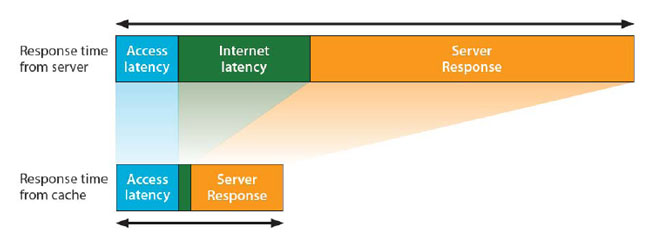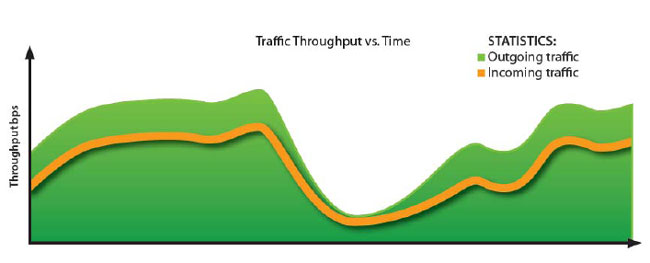
Articles
Caching Improves User Experience in 4G LTE Networks
Antenna Systems and Technology
(March 5, 2013) 4G LTE
By Haig A. Sarkissian – Wireless 20/20
Over the past few months I have been running speed tests on my new iPhone 5 smartphone on the Verizon 4G LTE network. I have frequently gotten 10 to 15 Mbps download speeds and 5 to 8 Mbps of upload speeds. Sometimes I have seen speeds approaching 20 Mbps downlink. Although these are fast and impressive by most standards, my mobile internet user experience has not improved significantly. I still have to wait for web pages to download and video clips to buffer.
Wireless network operators are adding bandwidth by deploying 4G LTE networks to meet the growing data demands of smartphone users. This bandwidth will provide coverage and capacity; however this approach does not address the need for low latency.
Last year at Mobile World Congress (MWC 2012), I witnessed a demonstration of a small cell base station, which allowed me to experience instant updates on web pages and super fast downloads on popular YouTube videos and content. Data providers like Google recognize that low latency is a key requirement for their users. They believe that web page response times need to be in the range of 0.25 second in order to deliver exceptional user experience. Today’s LTE data networks are delivering 7 to 20 second of response time.
I have yet to see any 4G network operators implement such a solution to make their network fast not only for speed tests but to shorten response times, which is my measure of a truly improved user experience.
I cannot wait until LTE service providers start deploying this technology in large scale and I have been interested in which vendors would take the lead in productizing caching solutions for 4G LTE networks
Wireline networks have used content delivery networks (CDNs) and caching extensively in the Internet in order to reduce response time. I was interested in examining how embedding cache in wireless networks is being used to achieve significant reduction in response time and thus provide exceptional wireless user experience.
Caching is a mechanism for temporary storage of mobile data traffic, including HTML pages, images and video in order to reduce backhaul bandwidth and server load. The main benefits of caching are to reduce response time and improve network efficiencies.
Faster Response Time
Response time is used to describe the time it takes for a mobile
broadband user to request information by clicking on their device until
getting online, opening a web page or receiving the first frame of a
video clip. Hence response time includes the time to encode the packet
for transmission and transmit it, plus the time for that data to
traverse the access network equipment, including the base station,
backhaul, transport and the core network. Once at the core network, the
request often needs to be served over the Internet by a server at a
remote datacenter.
This Internet latency is highly variable and depends on the proximity of the data center to the mobile network operator’s point of connection to the Internet. Once at the datacenter, the request is subject to further processing by the server, including data gathering and checking. Although a minimum bound on latency is determined by the distance between communicating devices and the speed at which the signal propagates in the circuits, actual latency is often much higher because of packet processing by the Internet networking equipment. Data sent by the server is often subject to further data filtering, virus checking and scrubbing for unwanted information prior to deliver to the mobile device.
Reduced Backhaul Traffic
Advanced caching techniques promise to reduce the overall backhaul
traffic and improve network efficiencies. By incorporating large amounts
of storage (64 GB to 256 GB) in the base station, user data can be
pre-fetched and stored at the edge of the network for instant access by
the base station scheduler.
This data is often gathered during idle timeslots on the backhaul network, thereby significantly reducing busy hour traffic.
According to industry sources, up to 40 percent of backhaul traffic can be reduced at the busy hour. This significant reduction in busy hour traffic can translate to measurable cost savings of recurring monthly backhaul operating expenses. News events such as sporting bring many users to similar content in a short period of time, thereby creating traffic spikes. Caching at the edge of the network has an effect of smoothening of traffic spikes and averaging the backhaul traffic over a longer period of time.
Caching in the 4G LTE Network
Caching can be used by mobile network operators to store and serve
popular content in the network in order to provide instant access of
this content to mobile subscribers. Initially, caching is being
implemented in the core network as operators take a centralized approach
to caching. This reduces the uncertainties of Internet latency and
remote server response times.
As data traffic increases on LTE networks and backhaul links become congested, distributed approaches to CDN deployment are becoming practical, thanks to the IP architecture of LTE eNodeBs. These new techniques are promising further improvement in latency and network efficiency by pushing the cache to the edge of the network.
The benefits of CDNs in large wired networks have been well established. Working with LSI, a leading chipset vendor which supplies technologies for 4G network gear, we recently published a white paper that analyzes the business case for caching in wireless networks. Because caching reduces backhaul traffic, particularly peak busy hour traffic, the financial benefits of implementing caching in the core network as well as at the edge of the network were investigated. Using the WiROI Tool, an industry-recognized LTE business model, we calculated and translated the peak busy hour traffic reduction into OpEx savings for three sample markets.
At Mobile World Congress this year, I met with companies like Allot Communications, PeerApp and Altobridge who have developed caching solutions for 4G LTE networks. In addition, I witnessed a demo at the Intel booth showing small cells with imbedded caching, which demonstrated that the technology is one step closer to being available to consumers. I cannot wait until 4G LTE service providers start deploying this technology in large scale making their 4G LTE networks not just fast for speed tests but also responsive, which is my measure of a truly improved user experience.
WiROI™ is a trademark of Wireless 20|20, LLC. WiMAX™ is a trademark of the WiMAX Forum®.
All others are trademarks of their respective Companies. This information is subject to change without notice.

